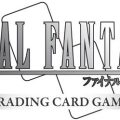Welcome to the official English column for FFTCG. This edition features the column “Understanding Valuation!” by Kurosawa-san, the 2019 World Champion. Although the article dates back to 2020, it still offers essential insights into the fundamentals of FFTCG gameplay, so be sure to check it out.

◆Introduction
Hello, I’m Kurosawa, a player of FFTCG.
Today I would like to introduce the fundamental technique in FFTCG known as “Valuation.”
Valuation is the act of evaluating cards.
It is a foundational skill for both deck building and gameplay. However, there hasn’t been much detailed explanation provided in articles thus far, which has led me to write this piece.
This article is intended as a stepping stone for those who aspire to win, achieve more victories, or even clinch a championship at competitive events such as the MASTERS series or other competitive events around the globe. Veteran players might find the content a bit basic, but I hope it serves as a good review.
Moreover, this article is divided into two parts. In this first part, we will cover:
1.Why Valuation is necessary
2.Considering returns in terms of “value” and “consistency“
3.What constitutes the element of “value” in returns
The follow-up article will delve into:
4.What constitutes the element of “consistency“ in returns
5.Valuation during matches
6.Reconsidering your deck
Although it’s a bit lengthy, I appreciate your patience and hope you find it informative.
Let’s get started.
◆Why is Valuation Necessary?
First, let’s discuss why Valuation is essential.
Have you ever experienced the following while playing FFTCG?
—
To break a stalemate, you played several forwards and 【1-083H】Maria in one turn, scoring some damage, but then you ran out of cards, couldn’t keep up with your opponent’s moves, and lost.
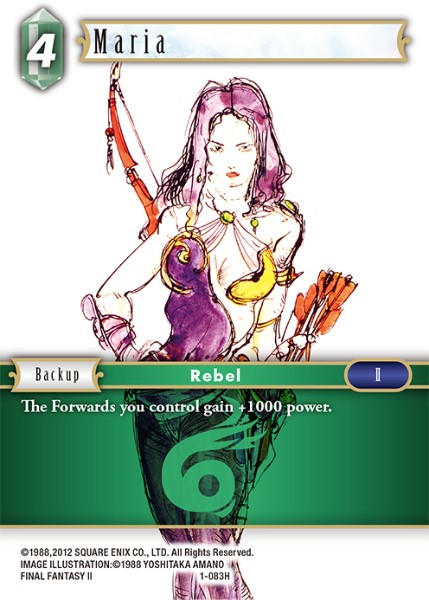
Trying to match an aggressive opponent’s pace, you found yourself with one less backup, repeatedly deploying forwards and performing removals, but gradually lost the hand advantage and lost the game.
After lining up five backups in the early game, ready to go on the offensive, you managed to deal some damage, but your opponent gradually caught up in backups and eventually outpaced you, leading to your loss.
—
These kinds of defeats are not uncommon in FFTCG. While it could be due to luck with draws, often these losses can be attributed to failed Valuation.
In FFTCG, you start with five cards in hand and draw two each turn, except for the first turn if you’re going first. This rule is the same for both players, meaning the resources available during the game are equal.
The difference in winning or losing then comes down to the returns gained for the cost paid.
Just like how people with the same salary can have different amounts of expendable income depending on their costs.
Thus, aiming for victory, it seems logical that “maximizing return on cost” is the most efficient strategy.
But to judge efficiency, how should one think about it concretely?
To do this, it’s necessary to clearly understand the cost paid for using a card and the return gained from its use.
The cost is visible on the top left corner of the card, but understanding the return requires some thought.
This skill to quantify returns, to translate them into comprehensible numbers, is Valuation.
We’ll explain more in the following sections, but first, let’s acknowledge the advantages of expressing things in numbers:
・If it’s numerical, it’s easier to compare card sizes.
・It helps eliminate biases like assumptions or misunderstandings.
You might be wondering, “Even though cost and power are numerical, cards have lots of text; can everything really be represented by numbers?” Indeed, it’s practically impossible to fully express all information on a card numerically.
Take 【10-023H】Unei, for example.

If asked, “How much do you gain by playing this card?” it’s unlikely anyone could answer immediately. Neither can I.
But what about 【9-094L】Fusoya?

Compared to 【10-023H】Unei, doesn’t it feel a bit easier to evaluate?
This is because 【9-094L】Fusoya contains a lot of numerical information in its text.
Its power is “6000,” it adds “2 cards” to your hand, and deals “cost × 1000” damage. Because of these clear numerical values, 【9-094L】Fusoya is easier to value (not necessarily stronger, please note) compared to 【10-023H】Unei.
Thus, numbers become materials for judging efficiency.
Of course, not all elements can be quantified, and the value of a card changes depending on the situation, so numerical values aren’t absolute evaluations, but are instead relative.
Nonetheless, the practice of quantifying various factors and anticipating returns for your actions, i.e., Valuation, is significantly meaningful if it reduces instances of “losing despite playing well,” aligning with our initial objective.
So far, we’ve discussed the importance of Valuation.
Next, let’s look at how to define returns.
◆Considering Returns in Terms of “Value” and “Consistency”
To define returns, let’s first return to the rules of FFTCG.
Over the course of a game, you draw cards randomly from a 50-card deck. The cards in the deck are not random, however; they are chosen by you. If they were random, it wouldn’t be a deck, just a pile of cards.
It therefore goes without saying that, when building a deck, it’s crucial to decide on a concept and then add or remove cards to balance it according to that concept.
Additionally, when constructing a deck, it’s standard practice to choose cards not only individually but also for their synergistic effects when combined.
This is to say that in pursuit of victory it is just as important to make good Valuation decisions during deck building as it is for in-game decisions.
However, as stated at the outset, the draw during the game is random, so whether or not combinations of cards will materialize involves randomness. Even if you think you’ve managed well, it doesn’t guarantee that returns will be realized.
This randomness is, as the name suggests, random, so it can’t be precisely quantified, but we introduce the concepts of “Value” and “Consistency” to make it as easy to understand as possible.
◆What Constitutes the Element of “Value” in Returns
Value refers to the worth that a card is expected to produce when played, while consistency refers to the likelihood of that value being actualized in-game.
In other words, it’s an approach to clarify overall returns by separating the perspective of a single card and the randomness associated with that card.
Let’s delve into these concepts one by one.
In FFTCG matches, forwards often play a central role, so let’s start with the value of forwards. Since the cost and power of forwards are prominently written on the card, let’s focus on these.
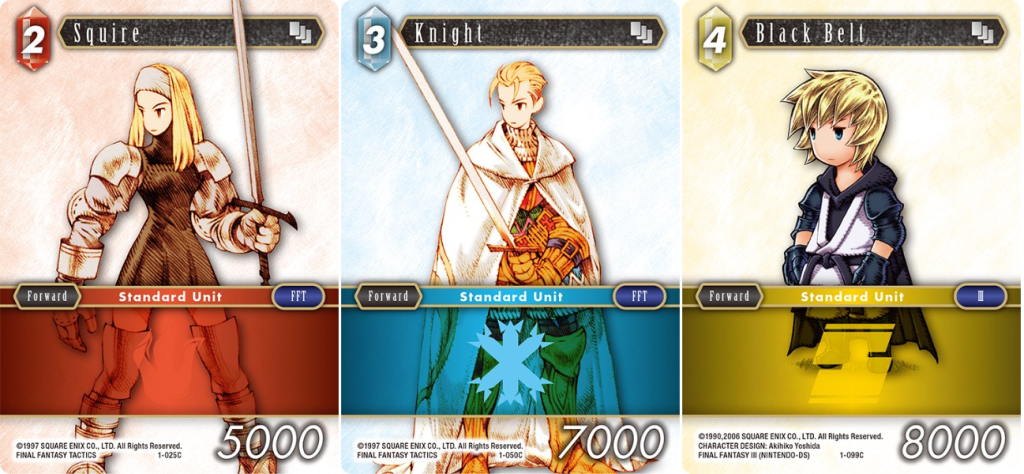
FFTCG has a rough guideline in game design: “A forward with a cost of 3CP should have 7000 power, and for each 1CP increase or decrease in cost, the power increases or decreases by 1000.” This can be considered the “market rate” for value, and is colloquially referred to as the “curve”.
Although there are exceptions, many cards fit this rule, allowing us to use it as a baseline.
As such, in very basic terms, it can be thought that 1CP is worth 1000 power.
For example, if your (stronger than the baseline) 3CP 8000 power forward clashes with your opponent’s (baseline) 4CP 8000 power forward, you can consider having gained 1CP worth of advantage. It can also be seen as the opponent losing 1CP, but since the resources available during the game are equal, these statements are equivalent.
Using this baseline for cost versus power, let’s delve deeper into the value of forwards.
Now, what about the smaller text, the abilities, written on the forward cards? Let’s compare these two as an example.

【4-048L】Locke has three abilities, but first let’s focus on the top auto-ability: “When Locke enters the field, if you control 2 or more Category VI Characters other than Locke, your opponent discards 1 card from his/her hand.”
Such “When X enters the field, do Y” auto-abilities can be easily handled when considering value.
In FFTCG rules, discarding 1 card from the hand generates 2CP. Thus, this auto-ability can be reinterpreted as: “Playing 【4-048L】Locke on the field causes the opponent to lose 2CP worth of total resources that can be used during the game.”
If your 【4-048L】Locke clashes with your opponent’s 【1-050C】Knight, you could also consider having gained 2CP worth of advantage. Here, we ignore the condition “if you control at least two other Category (VI) characters other than Locke,” but when considering value, we assume such conditions of “When X enters the field, do Y” are met. The part about conditions will be covered in the concept of “Consistency” in the next article.
Let’s also touch on 【4-048L】Locke’s other abilities.
The special ability “Mirage Dive” doesn’t directly gain CP but can be effective in certain situations. 【1-050C】Knight, when closely examined, also has a small icon in the upper right,
Another ability of 【4-048L】Locke is “When Locke deals damage to your opponent, your opponent discards 1 card from his/her hand.” This will also be explained in the section on “Valuation During Matches” in the next article.
Next, let’s consider the value of summons.
A common effect of summons is to “Choose one forward. Deal it damage / Break it / Return it to the hand.” While there are summons with different effects, let’s think of summons as “entities that interfere with forwards” for the purpose of this discussion.

For those of you who have read up to this point, you might already guess what I’m trying to say with the above cards.
That’s right. Using 【1-023R】Brynhildr on 【1-050C】Knight is an equivalent exchange, but using it on 【4-048L】Locke results in a 2CP loss.
You might think, “Isn’t that obvious? I can figure that much out.” However, the goal of valuation is to become able to make such “gain or loss” judgments in all sorts of situations.
Even in complex situations with multiple forwards and backups on both sides, each player casting summons against the other, if you can think, “Ah, this is like using 【1-023R】Brynhildr on 【4-048L】Locke. It’s a bit of a loss. What should I do?” then you’ve become significantly stronger through valuation.
I digressed a bit there. We were talking about the value of summons.
Generally, summons are designed such that they can remove a forward equivalent to the cost of that summon.

For example, 【1-124R】Odin can break forwards up to 4CP, and the 8000 damage from 【4-016R】Bahamut matches the standard power for a 4CP forward.
By applying this, we can more deeply and accurately consider the value of auto abilities of forwards like 【9-084H】Kain and 【11-090L】Kuja.
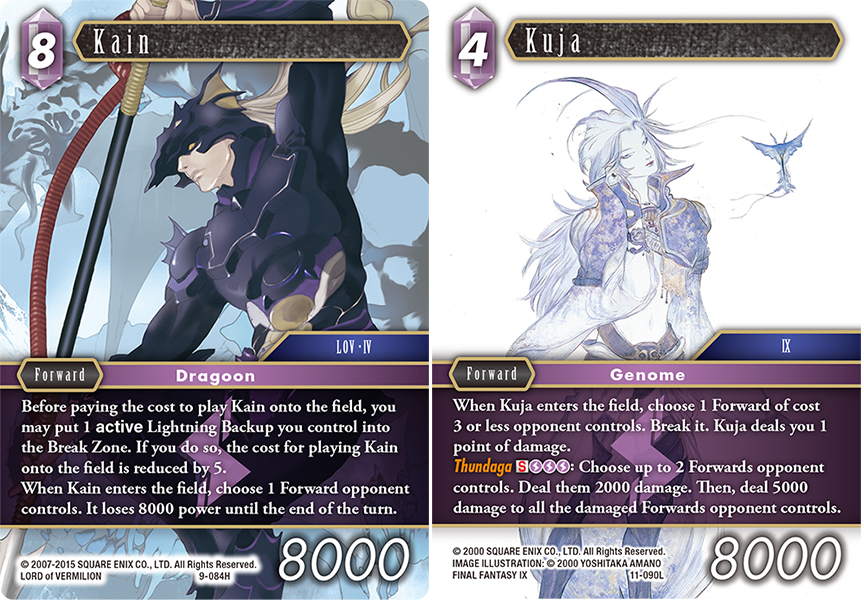
【9-084H】Kain, seen as incorporating a summon that removes forwards up to 8000 power, can be interpreted as gaining up to 6CP when played (note we assume here a 4CP forward with 8000 power has a value of 4CP plus 1 card = 2CP, totalling 6CP in value).
Since 【9-084H】Kain remains on the field as an 8000 power forward after resolving its auto ability, it’s considered equivalent to a cost of 4CP, effectively making the real cost 8CP a 4CP loss.
Combining these, 【9-084H】Kain can be seen as a card that gains 2CP.
Similarly, 【11-090L】Kuja, being a 4CP, 8000 power forward with a bonus, matches the standard value, and its auto ability provides up to 5CP gain, making it a card that overall gains 5CP.
Next, let’s delve into the value of backups.
The key point is, by having backups on the field, you can recover CP every turn. It’s like making a real estate investment within your salary to earn rental income.
As a standard for backups, consider a cost 1 backup with no ability. A cost 3 backup that searches for something, if we consider a card in hand = 2CP, then it’s effectively cost 1, so it’s standard in terms of cost. The bonus part could be whether it has an icon or allows for hand replacement.
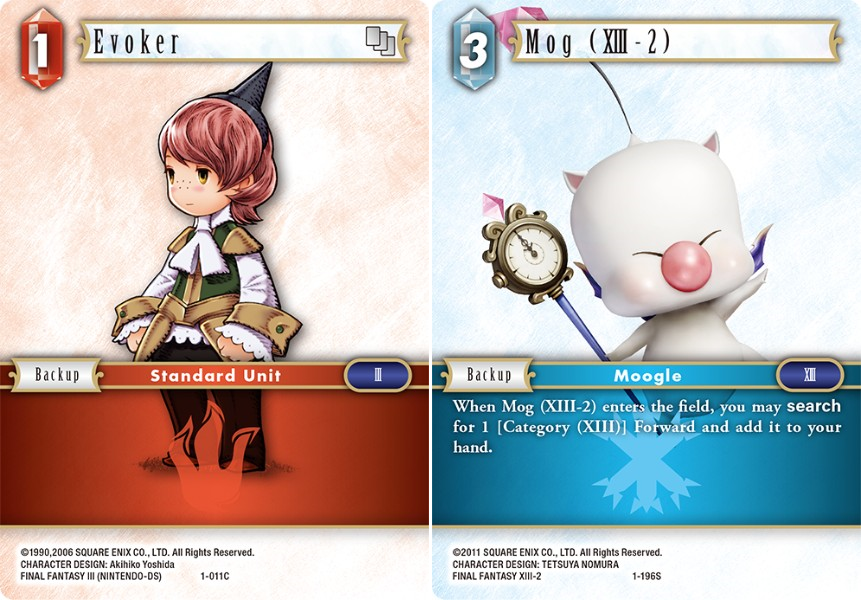
Based on these standards, let’s think about the value of higher-cost backups.
【1-137R】Seymour, which has an auto ability “When entering the field, do X,” can be considered similar to forwards.
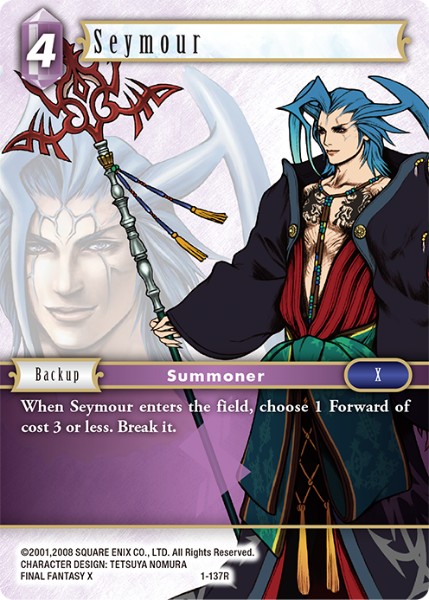
Gaining up to 5CP when played, it’s a 3CP loss compared to the standard, so overall, it’s a 2CP gain.
What about backups with field abilities like 【1-030R】Lebreau?
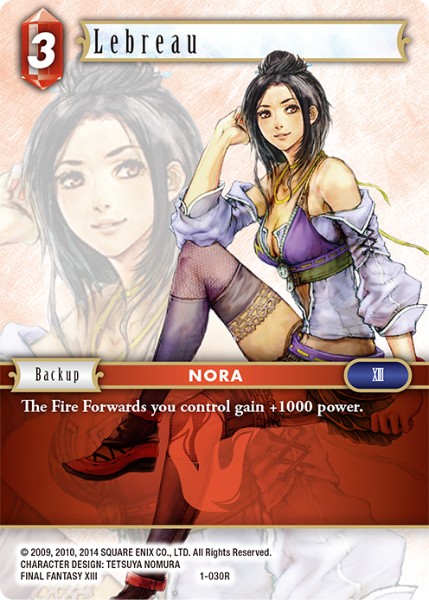
It’s a 2CP loss compared to the standard. Remembering 1000 power = 1CP, it can be interpreted as enhancing the value of your fire attribute forwards by 1CP each.
Thus, if you play two fire attribute forwards, you’ve recouped the cost, and from the third forward, you’re gaining 1CP for each. This is the essence of Valuation.
When considering the value of backups, such assumptions often make understanding easier.
Returning to the start of the article, “playing 【1-083H】Maria and losing,” it’s possible that since 【1-083H】Maria requires playing more than three forwards to be cost-effective, it didn’t provide the expected return.
 We’ve discussed value up to this point and touched on consistency.
We’ve discussed value up to this point and touched on consistency.
To conclude, here are the basic points for considering value:
・Expressing gains and losses from the standard values set for each cost
・1000 power = 1CP
・One card in hand = 2CP
By translating in this manner, you should be able to fairly accurately gauge the value of most cards. Note, the approach to monsters doesn’t differ from that of forwards or summons, so their explanation is omitted here.
◆To Be Continued in the Second Part
This article series, which explains the technique of “Valuation” – quantifying and evaluating the value of cards and plays, has covered in the first part the necessity of valuation, breaking down cards into the two elements of “Value” and “Consistency,” and what exactly “Value” means.
To summarize the last points:
・Expressing gains and losses from the standard values set for each cost
・1000 power = 1CP
・One card in hand = 2CP
While these concepts may seem simple, they serve as important guidelines in FFTCG, where constant decisions need to be made regarding whether to play a card or convert it into 2CP worth of cost, or if playing a certain backup will yield returns worth the CP spent. These considerations mark the first step in valuation and can be a useful reference when you’re unsure how to proceed with your card plays.
I hope this article serves as a useful reference for readers.
See you in the second part of the article.
Wish you a great FFTCG life!

